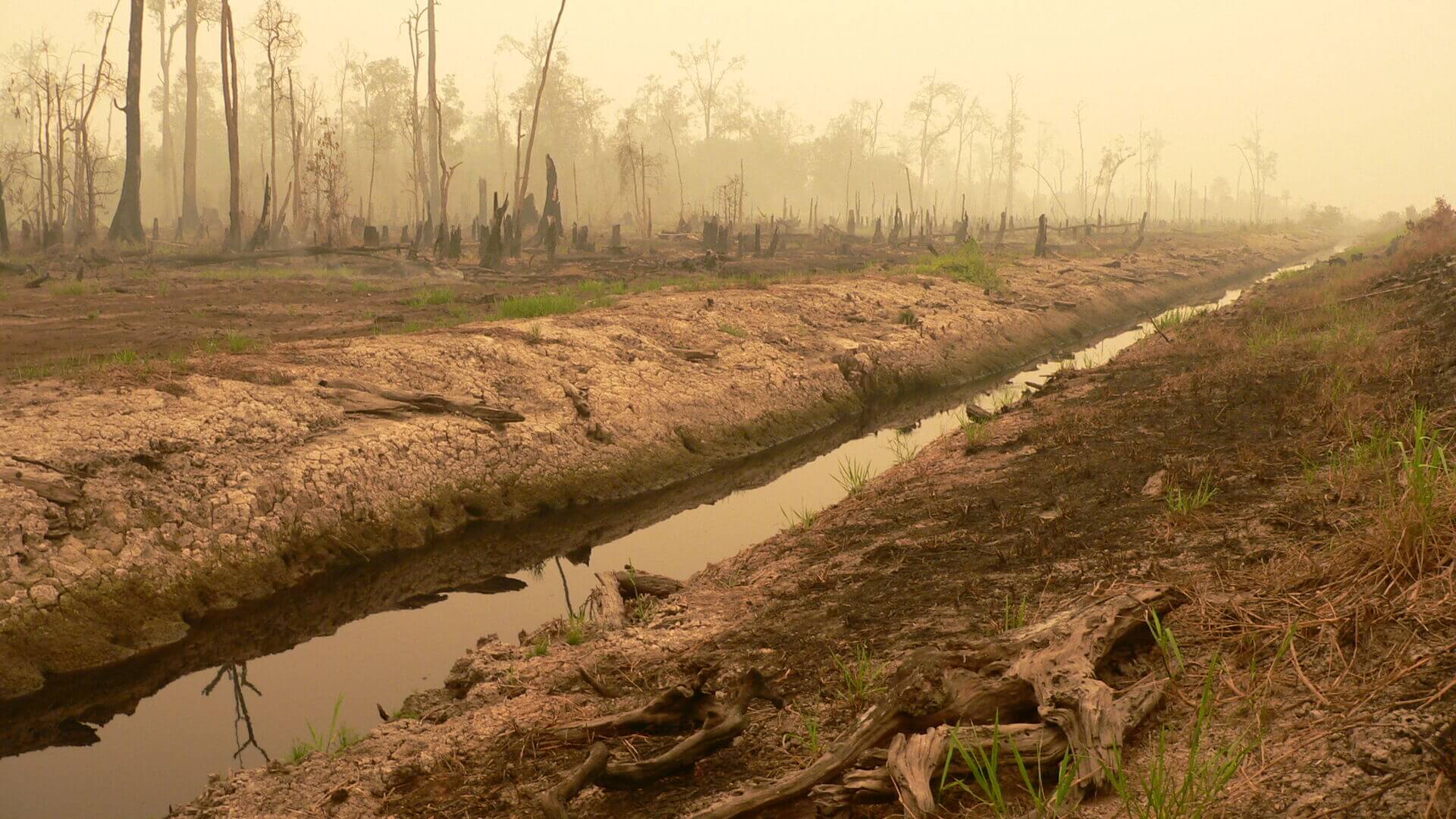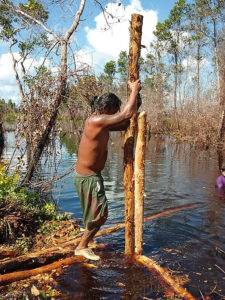The peatswamp forest of Mawas
This is the name of an area on Borneo about three times the size of Berlin. On an area of about 300,000 hectares stands one of the largest contiguous peat swamp forests in Indonesia. This tropical rainforest is home to about 2500 wild orangutans.
A Step into the Future: Protected Area for Climate and Species Preservation
Borneo is one of the last large forested islands on Earth that has undergone massive deforestation over the past three generations. The Mawas protected area has not been spared from this, as nearly one-third of the forest in the southern peat swamp has been destroyed.
Why Was the Forest Destroyed?
As part of a food supply project initiated by the Suharto government, rice cultivation on a large scale was planned for Mawas in the mid-1990s. During this so-called mega rice project, approximately 4,000 kilometers of drainage canals were excavated, which led to the desiccation of the wet peat swamp soil and provided access to the dense forests of Mawas. These canals were employed for systematic forest clearing and timber transportation. What remained after the clearing were barren stretches of land reminiscent of lunar landscapes. However, the rice cultivation ultimately failed, leading to the failure of the entire project.
This man-made destruction has disrupted an entire ecosystem, with far-reaching consequences for all of us and our global climate. CO₂ and other greenhouse gases continue to escape into the atmosphere from the dried peat soil. Additionally, the dried and exposed peat serves as ideal kindling for forest fires, especially during the dry season. This poses a constant safety risk, not only for the still-existing pristine primary forest but also for the local communities and wildlife.

What is BOS doing in the peat swamp forest of Mawas?
In short, we repair this damage and restore habitats, not only for many endangered animal species (including orangutans) but also for the local population in neighboring villages. Our efforts also contribute to the protection of our global climate and the creation of a livable future for the next generations.
To achieve these goals, we collaborate with the local community to construct dams, which raises the water levels around our afforestation areas. This action helps rehydrate the dried-out peat swamps and directly reduces the risk of forest fires. Once the soils in our afforestation areas have been sufficiently rewetted, we plant them with indigenous tree species adapted to the location. This approach allows us to combat the emission of CO₂ and other climate-damaging greenhouse gases, as well as to absorb and sequester additional CO₂ in the long term, all while creating new habitats.
What are the challenges for peat swamp forest protection in Mawas?
The drastic intervention in Mawas’ fragile ecosystem has created a complex set of problems. The main challenges include:
Drainage
Water continues to drain constantly from the peat swamp soils, resulting in lower water levels than what would occur naturally.
Fire Risk
The low water levels significantly increase the risk of fires. Without the original vegetation, the peat becomes vulnerable to the sun and unstable, especially during dry periods. Repeated forest fires create a vicious cycle because the already burnt peat is highly flammable and acts as a catalyst for future fires. Another major danger is that peat can also burn underground, making extinguishing fires that break out challenging and posing an even greater threat.
Greenhouse Gas Emissions
Approximately 80% of Indonesia’s greenhouse gas emissions are linked to releases from peat soils. The annual forest fires during the dry season are particularly detrimental to our global climate. With each fire, there is a risk of it spiraling out of control and causing further damage to intact soil, releasing substantial amounts of CO₂.
Illegal Deforestation
To this day, man-made canals in the Mawas area are used to transport illegally logged timber to sawmills and for sale. Consequently, hundreds of trees are illegally cleared from the pristine forest every month.
New hope for Mawas
You are currently viewing a placeholder content from YouTube. To access the actual content, click the button below. Please note that doing so will share data with third-party providers.
More InformationRestore and protect: BOS solutions for Mawas
Reforestation
Reforestation of degraded land stabilizes the peat soil. Seedlings, measuring 20 to 30 centimeters in size, are sourced from tree nurseries in neighboring villages and planted. After planting, we meticulously clear the seedlings of overgrowth that might otherwise obstruct their access to light. This maintenance occurs regularly over a three-year period. Due to the threat of fires in our reforestation areas, the seedlings are also protected from potential forest fires through patrols and the installation of hydrants.
Fire prevention
As peat fires are challenging to control or extinguish, early detection is crucial. That’s why we routinely patrol the hotspots during the dry season. Within our afforestation area, we conduct daily patrols during this time. This proactive approach has been instrumental in detecting and extinguishing several fires at an early stage.
Dam construction and rewetting of the area
As long as the canals of the mega-rice project continue to drain water from the area into the adjacent rivers, the water level remains dangerously low, especially during the dry season, and the peat soil becomes excessively dry. With each dam that we construct, which retains water and prevents further drainage, the water level rises.
Community development
Together with the Indonesian population in the Mawas area, we have developed a reforestation program that involves all decision-makers. We believe that conservation can only succeed through close cooperation with all affected parties, and that this is the only way to ensure a sustainable future for the local communities, but also for all of us.
Forest for life
Save the rainforest
Saving the orangutans cannot succeed without preserving their habitat! Mawas is a thousand-year-old peat swamp rainforest housing one of the largest wild orangutan populations in Indonesia. Although significant portions of this unique rainforest were lost as part of a megaproject in the 1990s.
Now, we have a vision: To restore the forest and make it a home for even more orangutans.
Forest for life
Save the rainforest
Saving the orangutans cannot succeed without preserving their habitat! Mawas is a thousand-year-old peat swamp rainforest housing one of the largest wild orangutan populations in Indonesia. Although significant portions of this unique rainforest were lost as part of a megaproject in the 1990s.
Now, we have a vision: To restore the forest and make it a home for even more orangutans.

You have a question?
Donations are a matter of trust
Transparent use of funds is a matter of course for us. In September 2013, we joined the a non profit initiative of Transparency International Germany and signed its declaration of commitment.

